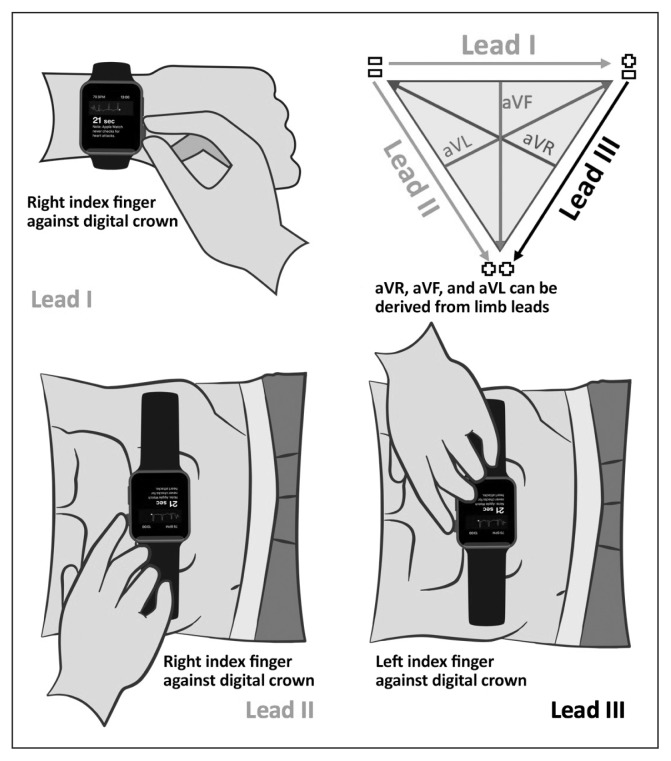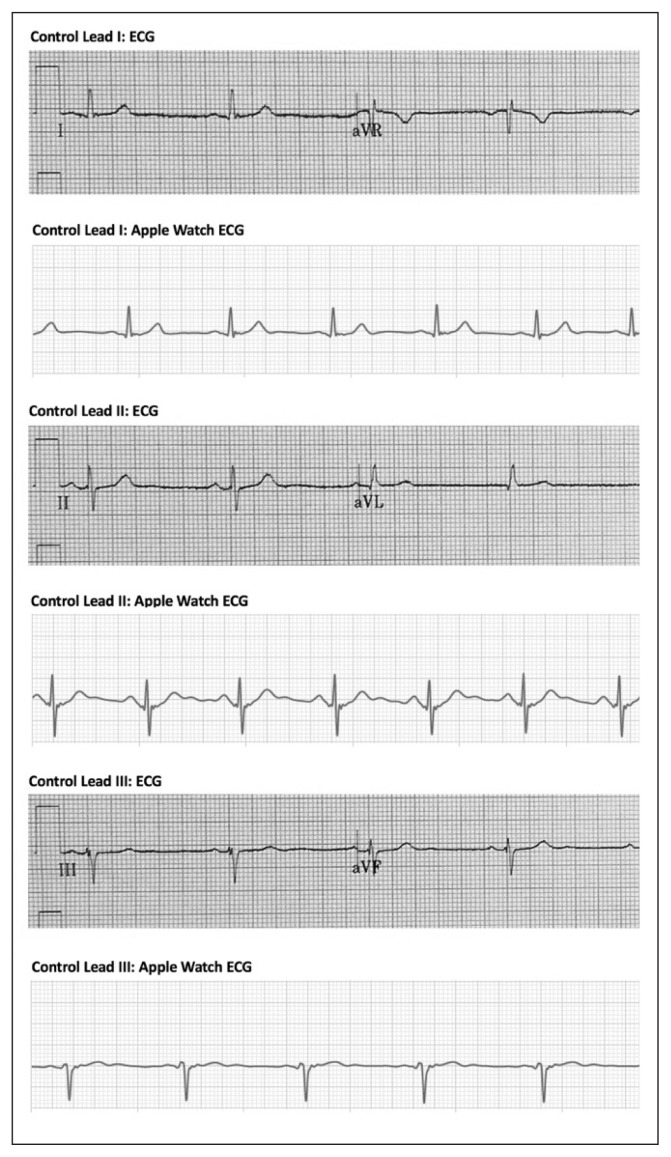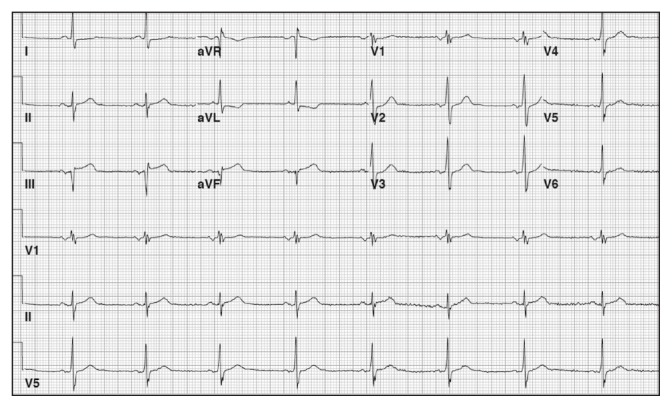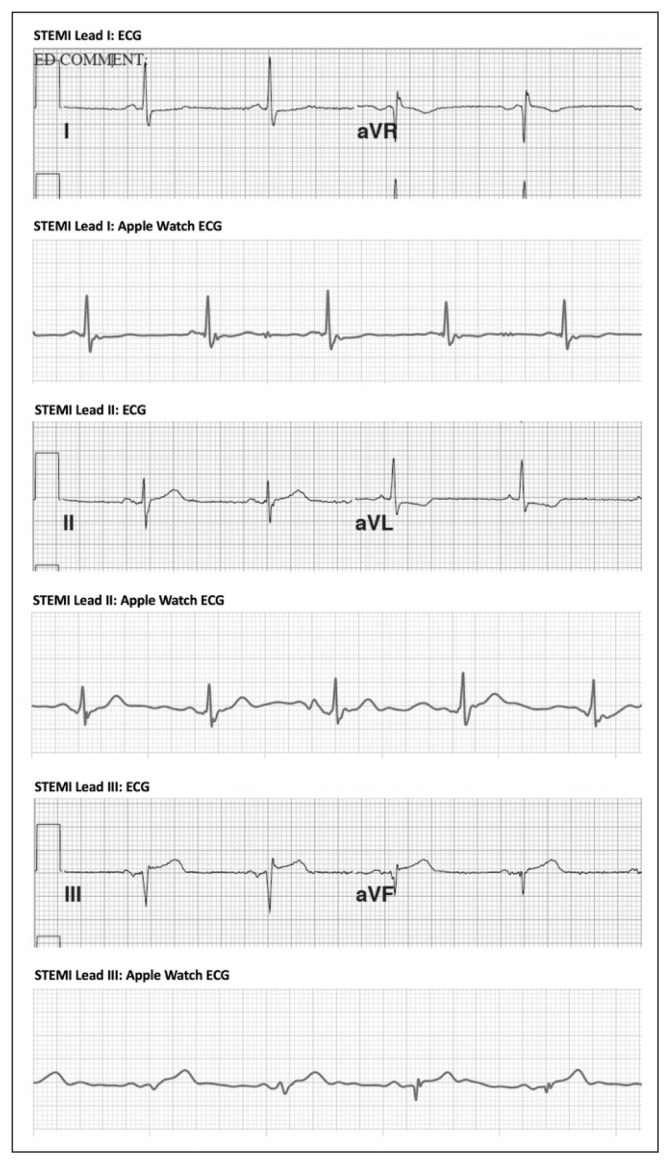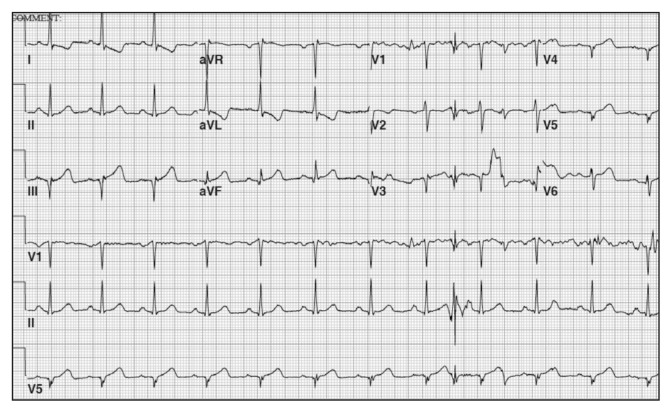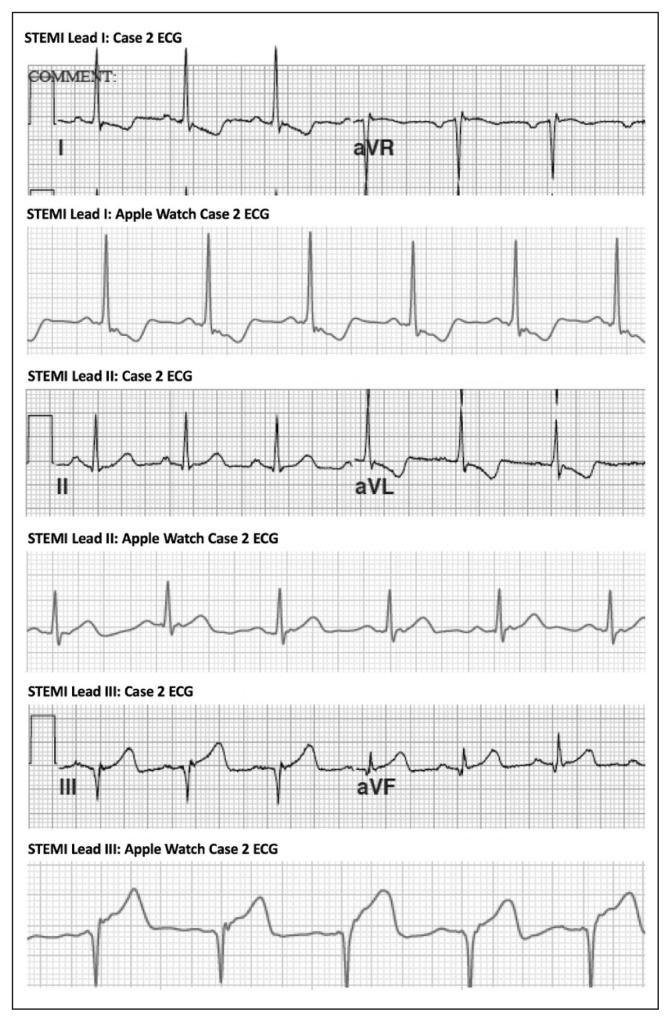Abstract
Background
Early recognition and treatment of ST-elevation myocardial infarction (STEMI) results in better outcomes.
Objectives
To describe a novel technique using the Apple Watch 4 (Apple Inc, Cupertino, CA) to obtain a 3-lead electrocardiogram (ECG) and confirm the watch’s feasibility to detect cardiac ischemia in selective cases with a particular injury pattern.
Methods
Two male patients in the Emergency Department had STEMI apparent on their ECGs. These findings were compared with those from the Apple Watch 4, whose positioning was adjusted for 3-lead ECG.
Results
The patients’ real-time, watch-based, 3-lead ECG tracings matched the traditional ECGs demonstrating STEMI, confirming the potential ability of this device to uncover myocardial ischemia. In each patient, cardiac catheterization revealed severe, 100% occlusion of the right coronary artery.
Conclusion
The Apple Watch 4 could lead to earlier detection of acute coronary artery disease, but sensitivity and specificity remain unknown.
Keywords: Apple Watch 4, Apple Watch 4 as electrocardiogram, cardiac ischemia, detection of acute coronary artery disease, ECGs demonstrating STEMI, novel use of Apple Watch 4
INTRODUCTION
One in 4 people die of heart disease in the US.1 Urgent revascularization is indicated in patients with ST-elevation myocardial infarction (STEMI), and earlier treatment reduces morbidity and mortality.2 Multiple barriers have been identified in preventing the early recognition of STEMI, including preexisting bias of symptoms, incorrect rationale, attribution to other medical conditions, and lack of awareness of the importance of rapid treatment.3–5 There are educational recommendations for health care practitioners, patients, and family to receive information about acute myocardial infarction to improve on treatment delays.6,7 Extending the availability of electrocardiograms (ECGs) could lead to earlier recognition and prompt treatment of acute coronary artery disease.
Millions of people own the Apple Watch 4 (Apple Inc, Cupertino, CA), which can perform a single-lead ECG.8,9 Inadvertently, I noted the watch’s ECG lead reversal when wearing the watch on the right wrist instead of the left. Subsequently, I tested the watch’s capability to create a 3-lead ECG by adjusting the positioning of the watch using the Einthoven triangle as a guide. The watch has electrodes built into the digital crown (negative) and the back crystal (positive) to detect cardiac electrical signals. Lead I can be obtained using the watch as intended: Wearing the watch on the left wrist and the right index finger touching the digital crown. However, leads II and III can also be obtained by placing the positive electrode (back of the watch) against the midabdomen and using the negative electrode (digital crown) with the right or left index finger (Figure 1).
Figure 1.
Positioning of Apple Watch 4 for 3-lead electrocardiography.
METHODS
By adjusting the use of the Apple Watch 4, as shown in Figure 1, a 3-lead ECG can be obtained. These lead tracings were confirmed in control participants (Figure 2). Additionally, the watch’s 3-lead ECG was tested in 2 patients to determine concordance with ECGs showing STEMI.
Figure 2.
Electrocardiogram (ECG) lead tracings vs Apple Watch 4 tracings in control.
RESULTS
Case 1
A 52-year-old man presented to the Emergency Department with chest pain. He reported that his symptoms started “fairly quickly” with 9 of 10 epigastric and retrosternal chest pressure. He reported a history of back pain, but this episode was “much worse than usual” and involved his chest. On presentation, his ECG revealed a STEMI. There was notable ST-segment elevation in leads III/aVF with reciprocal changes including ST-segment depression I/aVL (Figure 3). Results of the initial laboratory studies were notable for an elevated troponin level.
Figure 3.
Electrocardiogram reveals a ST-elevation myocardial infarction in a 52-year-old man (case 1).
The patient was treated for acute coronary syndrome. While the patient was awaiting transport to the cardiac catheterization laboratory, I obtained informed consent to perform a 3-lead ECG with the Apple Watch 4 to determine concordance of its leads against the patient’s STEMI-demonstrating ECG (Figure 4). The real-time, watch-based, 3-lead ECG tracing matched the traditional ECG waveforms. Cardiac catheterization revealed severe, 100% occlusion at the ostium of the right posterolateral branch of the dominant right coronary artery.
Figure 4.
Lead tracings of traditional electrocardiogram (ECG) and Apple Watch 4 in case 1.
STEMI = ST-segment elevation myocardial infarction.
Case 2
A 68-year-old man arrived at the Emergency Department with chest pain. His symptoms started while working in the yard. He described the pain as pressure with associated nausea and vomiting. On presentation, his ECG also revealed a STEMI with notable ST-segment elevation in lead III/aVF and reciprocal ST-segment depressions in lead I/aVL (Figure 5). He was treated for acute coronary syndrome. I obtained informed consent to perform a 3-lead ECG with the Apple Watch 4 to determine concordance against the patient’s ECG demonstrating STEMI (Figure 6). The real-time, watch-based, 3-lead ECG tracing matched the traditional ECG waveforms. Cardiac catheterization revealed severe, 100% occlusion of the right coronary artery.
Figure 5.
Electrocardiogram reveals a ST-elevation myocardial infarction in a 68-year-old man (case 2).
Figure 6.
Lead tracings of traditional electrocardiogram (ECG) and Apple Watch 4 in case 2.
STEMI = ST-segment elevation myocardial infarction.
DISCUSSION
In these selected cases, the 3-lead ECG tracings obtained from the Apple Watch 4 matched the waveforms of the traditional ECGs demonstrating STEMI, confirming the potential ability of this smart watch to uncover myocardial ischemia.
Recent innovations in mobile health care technologies are disrupting traditional medical practice. Numerous publications reveal the use of these devices in early detection of arrhythmias, heart blocks, and cardiac ischemia.10–12 With this new watch function, the potential early detection of cardiac ischemia may permit earlier lifesaving intervention that could have a major impact on morbidity and mortality. The Apple Watch 4 reports a 98.3% sensitivity in atrial fibrillation detection.9 However, the sensitivity and specificity of the watch’s 3-lead ECG to detect cardiac ischemia are yet to be determined. The watch is also currently limited by an inability to detect precordial leads, which could miss cardiac ischemia in other cardiac regions. Further studies are needed to verify if the watch could yield valuable diagnostic information.
CONCLUSION
This article reveals a novel use of the Apple Watch 4 to obtain a 3-lead ECG. Adjustments to its software might yield the capability to obtain the augmented limb leads generating a 6-lead ECG. The watch has already received clearance from the US Food and Drug Administration for detection of atrial fibrillation13 and the novel technique described here could expand its function. This additional function of the watch may serve to implement a low-cost but high-value method of patient empowerment in the earlier detection of acute coronary artery disease.
Electrocardiography
This instrument—the string galvanometer—is essentially composed of a thin silver-coated quartz filament, which is stretched like a string, a strong magnetic field. When an electric current is conducted through this quartz filament, the filament reveals a movement which can be observed and photographed by means of considerable magnification.
— Willem Einthoven, 1860–1927, Dutch physician and physiologist who invented the first practical electrocardiogram, 1924 Nobel Prize winner in medicine
Acknowledgments
Kathleen Louden, ELS, of Louden Health Communications performed a primary copy edit.
Footnotes
Disclosure Statement
The author(s) have no conflicts of interest to disclose.
References
- 1.Multiple cause of death files, 1999–2013, CDC WONDER [Internet] Atlanta, GA: Centers for Disease Control and Prevention; [cited 2015 Feb 3]. Available from: https://wonder.cdc.gov/mcd.html. [Google Scholar]
- 2.O’Gara PT, Kushner FG, Ascheim DD, et al. 2013 ACCF/AHA guideline for the management of ST-elevation myocardial infarction: A report of the American College of Cardiology Foundation/American Heart Association Task Force on Practice Guidelines. Circulation. 2013 Jan 29;127(4):e362–425. doi: 10.1161/CIR.0b013e3182742cf6. . Erratum in: Circulation 2013 Dec 24;128(25):e481. [DOI] [PubMed] [Google Scholar]
- 3.Finnegan JR, Jr, Meischke H, Zapka JG, et al. Patient delay in seeking care for heart attack symptoms: Findings from focus groups conducted in five US regions. Prev Med. 2000 Sep;31(3):205–13. doi: 10.1006/pmed.2000.0702. [DOI] [PubMed] [Google Scholar]
- 4.Leslie WS, Urie A, Hooper J, Morrison CE. Delay in calling for help during myocardial infarction: Reasons for the delay and subsequent pattern of accessing care. Heart. 2000 Aug;84(2):137–41. doi: 10.1136/heart.84.2.137. [DOI] [PMC free article] [PubMed] [Google Scholar]
- 5.Rucker DW, Brennan TA, Burstin HR. Delay in seeking emergency care. Acad Emerg Med. 2001 Feb;8(2):163–9. doi: 10.1111/j.1553-2712.2001.tb01282.x. [DOI] [PubMed] [Google Scholar]
- 6.Dracup K, Alonzo AA, Atkins JM, et al. Working Group on Educational Strategies to Prevent Prehospital Delay in Patients at High Risk for Acute Myocardial Infarction. The physician’s role in minimizing prehospital delay in patients at high risk for acute myocardial infarction: Recommendations from the National Heart Attack Alert Program. Ann Intern Med. 1997 Apr 15;126(8):645–51. doi: 10.7326/0003-4819-126-8-199704150-00010. [DOI] [PubMed] [Google Scholar]
- 7.Alonzo AA. The impact of the family and lay others on care-seeking during life-threatening episodes of suspected coronary artery disease. Soc Sci Med. 1986;22(12):1297–311. doi: 10.1016/0277-9536(86)90093-6. [DOI] [PubMed] [Google Scholar]
- 8.Campbell M. Apple shipped 9.2M Apple Watch units in Q4 2018 to capture half of market, report says [Internet] AppleInsider; 2019. Feb 27, [cited 2019 Apr 15]. Available from: https://appleinsider.com/articles/19/02/27/apple-shipped-92m-apple-watch-units-in-q4-2018-to-capture-half-of-market. [Google Scholar]
- 9.Taking an ECG with the ECG app on Apple Watch Series 4 [Internet] Cupertino, CA: Apple Support; 2019. Mar 27, [cited 2019 Apr 15]. Available from: https://support.apple.com/en-us/HT208955. [Google Scholar]
- 10.Tabing A, Harrell TE, Romero S, Francisco G. Supraventricular tachycardia diagnosed by smartphone ECG. BMJ Case Rep. 2017 Sep;11:2017. doi: 10.1136/bcr-2016-217197. [DOI] [PMC free article] [PubMed] [Google Scholar]
- 11.Nyotowidjojo I, Erickson RP, Lee KS. Crowd-sourcing syncope diagnosis: Mobile smartphone ECG apps. Am J Med. 2016 Apr;129(4):e17–18. doi: 10.1016/j.amjmed.2015.11.022. [DOI] [PubMed] [Google Scholar]
- 12.Joseph JP, Redwood SR. Mobile digital health devices and the diagnosis in real-time of myocardial ischaemia. QJM. 2017 May 1;110(5):309–10. doi: 10.1093/qjmed/hcx046. [DOI] [PMC free article] [PubMed] [Google Scholar]
- 13.Apple Watch. Helping your patients identify early warning signs [Internet] Cupertino, CA: Apple Healthcare; [cited 2019 Apr 16]. Available from: www.apple.com/healthcare/apple-watch/ [Google Scholar]



